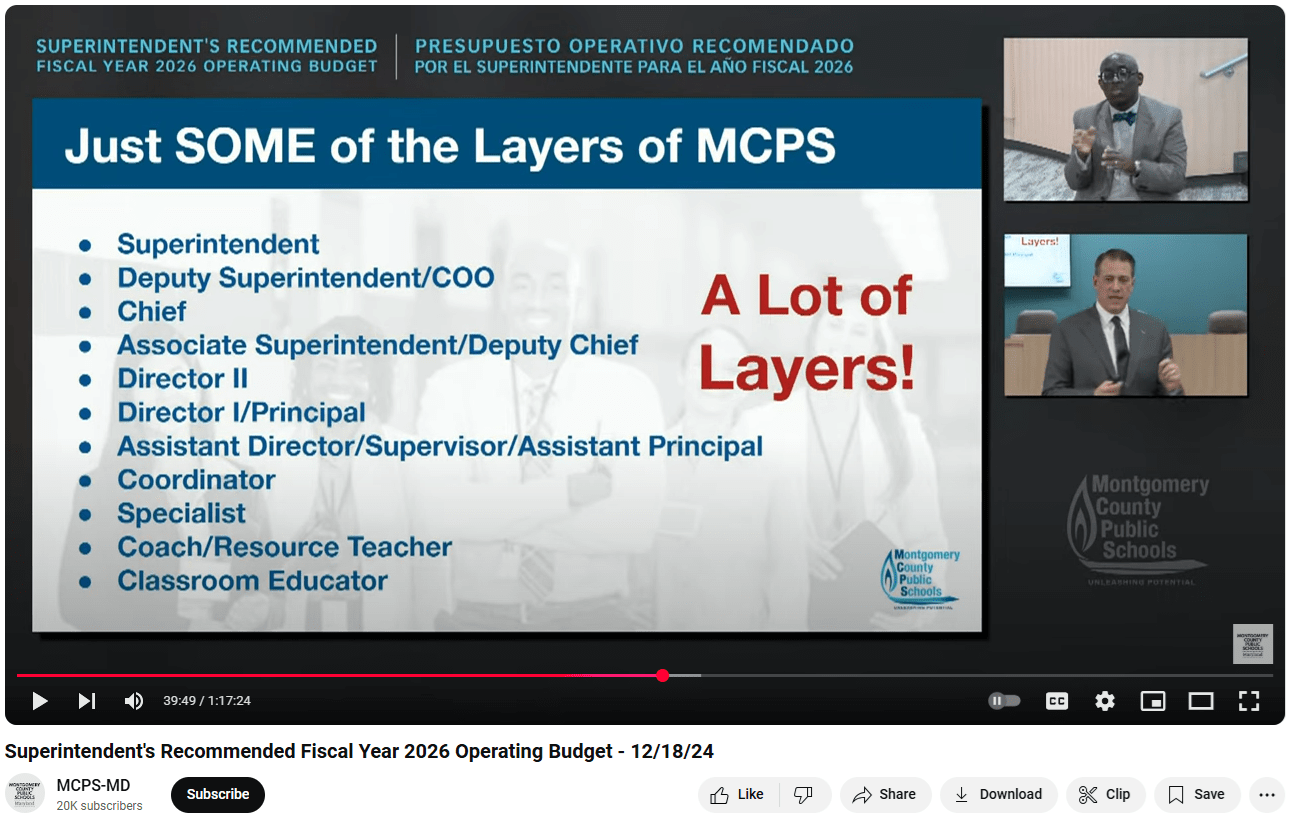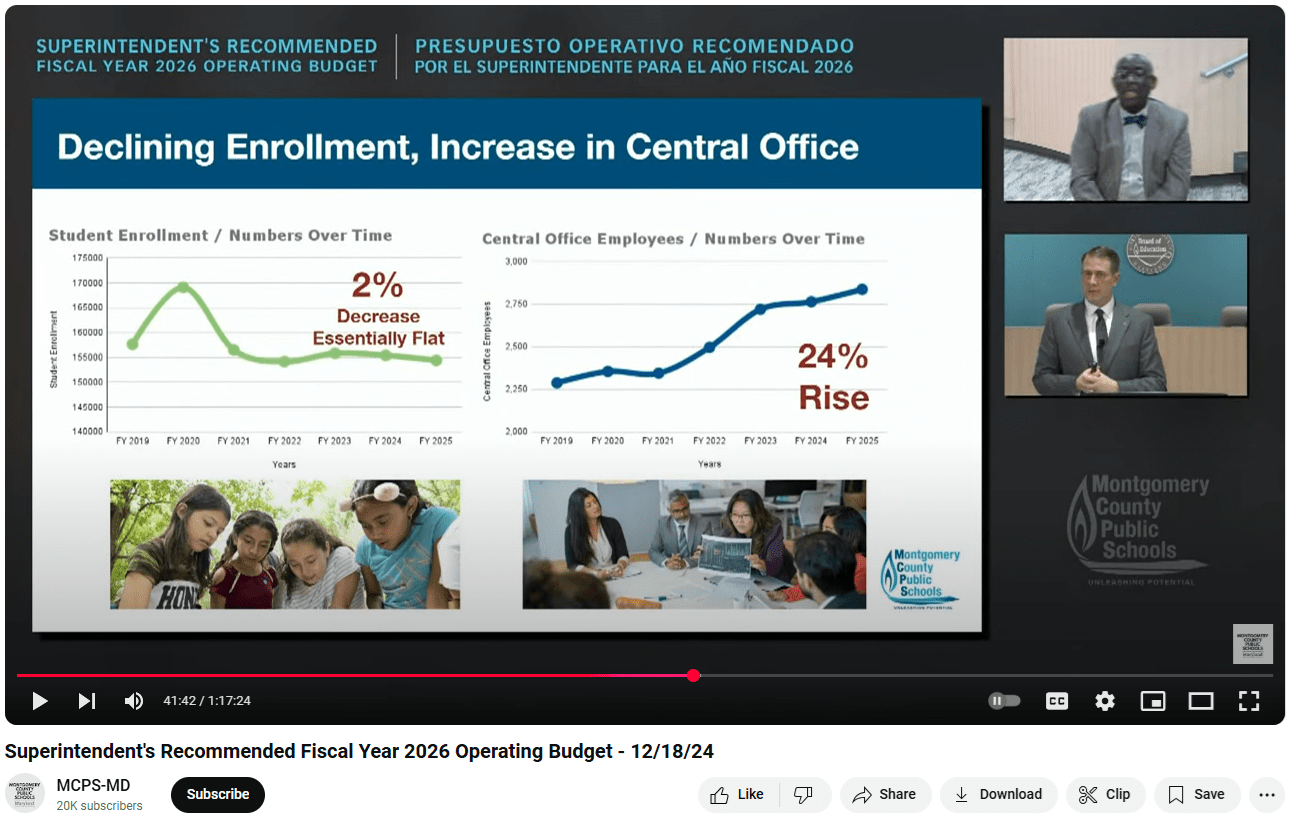By Adam Pagnucco.
In making a generationally colossal budget ask last month, MCPS Superintendent Thomas Taylor had a lot to say in an hour-plus presentation to stakeholders. (The video is worth a watch.) Among his many comments, one theme stood out for me: his criticism of the district’s central office. That’s not something you hear often in a budget presentation by MCPS leadership.
While it’s unusual for a superintendent to take on their own central office, it’s not unprecedented. Former Superintendent Jerry Weast trimmed the central office more than once early in his tenure and did it again during the Great Recession. But most of the time, superintendents would rather let the central office grow quietly while directing attention to the needs of the classroom.
That’s not Thomas Taylor.
Just months after taking office, Taylor announced job postings for eight senior positions in MCPS’s leadership team. That was part of a bigger plan. During his December budget presentation, Taylor discussed how many layers of management there are at MCPS with the slide below. He even noted that while the deputy superintendent layer was now gone, “There are lots of layers that are not reflected on this list, even which is a little scary. At my last count, I think it was 14 or 15 different layers in our organization.”

Does MCPS have more layers of management than the Pentagon?
After talking about the appropriate role of the central office, Taylor moved on to describing how its size has recently mushroomed. Here’s what he had to say along with a dramatic slide he used.
*****
So with that, I want to share something that’s a little bit disturbing and a little bit frustrating. So over the past five years we have kind of flattened out in terms of our enrollment. We’ve gone from 157,000 students right before the pandemic to right under 155,000 students. And that’s just K-12, that’s not pre-K and that’s not early education programs, it’s just our K-12 student population. Effectively, we’ve decreased by 2 percent.
During that same period of time, our central office staff has increased by 24 percent, going from over 2,200 employees to over 2,800 employees.

Taylor shows a slide contrasting flat enrollment with growth in the central office.
I can’t get my head wrapped around it because the level and affect of service either hasn’t changed or in many ways has actually gotten worse. We need to change. And it’s not because we have ineffective or bad people. We do not. We actually have very talented and very strong people. But we have to row in one direction. And we have to do it together. And we could be a little bit more streamlined and a little bit more focused and a little bit more effective.
*****
Taylor followed up these remarks with this statement from his recommended FY26 operating budget.
*****
In total, the base budget changes result in reductions totaling 81.5 FTE and $7,014,967. These reductions reflect a major reorganization in our central office and in the way we support our schools. Stakeholders both within the system and within our community experience and have expressed a high level of frustration with the many bureaucratic layers and the siloed operations in our central office. We have an important opportunity to reimagine how we are structured to provide responsive and effective central services so we can serve schools, students, and families differently. The number of MCPS central office positions has increased 24 percent between FY 2019 and FY 2025, while enrollment declined by 2 percent in the same time period and school-based positions increased 7 percent. This pattern of growth in central office is not sustainable, and does not focus system resources where they are needed most, in schools and in the classroom.
*****
An aside. I have questions about how Taylor defines “central office.” No such expenditure category appears in the state’s Financial Reporting Manual for Maryland Public Schools, which establishes uniform reporting standards for the state’s twenty-four local education agencies. The term “central office” is used six times but not defined in Taylor’s budget and it does not appear as a line item in any budget schedule. I will leave this issue alone for now but I will return to it in a future post.
Now let’s put this in perspective. Taylor says he is trimming $7 million from the central office but he is still asking for a total operating budget increase of $296 million. And while, according to his own statements, the central office has grown by roughly 600 positions in the last five years, he says he is trimming just 81.5 of them. Overall, he is asking for an increase of 882 positions throughout MCPS, of which 717 would be for special education.
Taylor is no Michelle Rhee. Remember her? Rhee was the chancellor of D.C. public schools who posed for this notorious 2008 Time magazine cover with a broom. She sparked labor warfare across her district with aggressive plans to sweep away the problems in D.C. schools. It did not go well.

Taylor did not bring a broom to his budget presentation.
One gets the sense that Taylor’s first budget is just a start in where he would like to take the district. It has to be since no one accomplishes everything they want to do in one year, especially in a gigantic organization like MCPS. The central office has few if any defenders in the broad MCPS community as it’s easy to criticize “bureaucrats,” so vows to cut it should get some support. Expect to see Taylor make this point again and again.
But if Taylor wants to get the historically huge budget increase he has proposed – one that may require a substantial property tax hike – he needs to do more than trim around the edges of his predecessors’ excesses. Taxpayers who pay a lot more have a right to expect better results in return.
We shall see if Taylor can deliver.
